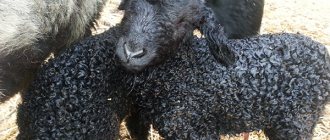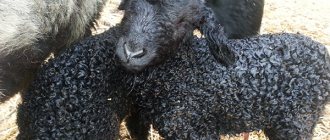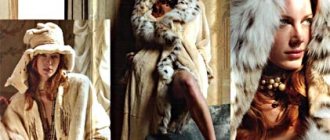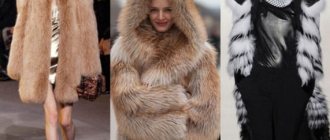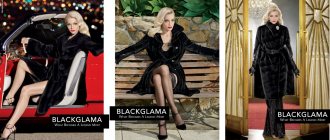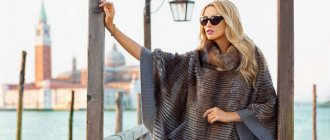Astrakhan fur coats are still relevant this season. Fur products look very original in comparison with models from other types of fur. The surface of the fur consists of very small curls that shimmer and sparkle beautifully in natural light. Fashionable astrakhan fur coats not only look beautiful, but also last for a very long time.
Features of doodle
The most common karakul skins are black; gray ones are less commonly found on sale. However, color transitions in gray fur are appreciated due to the fact that its curls are not as clearly expressed as on black. Brown has an increased cost. The most expensive is white, silver. This fur has its own name - swakara. Skins of this variety are especially highly valued.
Today, three types of karakul are known. This:
- Uzbek;
- Namibian;
- Afghan.
Astrakhan fur, produced in Namibia, is considered the most valuable. His curls are flat, extremely delicate, reminiscent of broadtail. The cost of such a fur coat (depending on the finishing) can reach up to 1 million rubles. Karakul from Afghanistan has a special shine; clothes made from it look luxurious. The most wearable and popular is Uzbek. It is light, elegant, and its skins are smaller in size than the first two types. Tailoring from Uzbek astrakhan fur is carried out most often - this is largely due to its moderate price.
Kinds
Black astrakhan fur is divided according to its origin. It happens, for example, Uzbek, Afghan and South African.
Unlike other varieties, the first type is the cheapest. The peculiarity lies in lightness with subtlety.
Afghan karakul has a ribbed-flat scroll pattern. The skins are larger in size and of better quality. Therefore, the price of this fur is higher.
South African is the most expensive. It is produced in remote Namibian regions. Wool is light and fine. Each of them has a beautiful curl.
Attention ! Also, astrakhan fur is divided into groups depending on the material, curls and elasticity.
Black look
What is the difference between astrakhan fur and astrakhan fur?
Karakul and Kurakulcha are the same type of sheepskin fur. Expanding on the topic of what kind of fur is astrakhan fur, it is worth pointing out that the difference is that astrakhan fur is the fur from sheep embryos, and astrakhan fur is the fur of one-day or three-day lambs that have reached their full maturity in the womb and were born.
Broadtail
How does astrakhan fur differ from other types?
Astrakhan fur is thick and silky. Its color is varied, but the most popular is black. It has a unique wool swirl pattern. Gray fur has color transitions and has a more straight structure. Chestnut and snow-white are in short supply. It costs the most.
Swakara: what kind of fur is this?
In answer to the question, what kind of fur is swakara, we can answer that swakara is the exclusive black, grey, brown or white fur of newborn Namibian lambs, which has a unique pattern. Since Namibian supplies are limited, swakara is highly sought after and expensive.
Swakara
Afghan karakul
It is distinguished by its large size and weight, flat structure and ribbed curlicue pattern. One canvas can reach a length of 1.2 to 2 meters. It has an extraordinary shine that adds chic to a product made from it. It has high quality and density.
This will be interesting to you. Everything you need to know about taffeta: what kind of fabric is it?
Attention ! In response to how this type of karakul is obtained, one can point out that it is obtained in the same way as all other types.
Afghan view
Peculiarities
Astrakhan fur is the fur of unborn lambs (flogged or miscarried), which is distinguished by its special silkiness, unique ribbed curl pattern, and soft flesh.
This fur is distinguished by short pile and undeveloped curls, which together create an unusual fur pattern in the form of long ribbed stripes, the so-called “moiré” with smooth transitions and tints of color.
The difference between astrakhan and astrakhan fur is that astrakhan has a stiffer pile and more formed curls, because Karakul is obtained from the wool of lambs about a week old.
Karakulcha is especially valued because of its rarity and uniqueness. The leaders in the astrakhan fur market are Uzbek and Afghan furs. The most valuable fur is the broadtail from South Africa, called swakara (short for South-West Africa KARAkul).
Svakara is the result of long work by breeders and therefore it is valued on a par with ermine and sable; supplies of this fur to the world market are limited.
Astrakhan fur has all the advantages of natural fur:
- softness;
- pleasant tactile sensations;
- ease;
- breathability;
- heat saving;
- versatility;
- durability.
Astrakhan fur has long been used to make hats, fur coats, capes, and collars. In past centuries, products made from astrakhan fur were heavy in weight. Modern technologies for processing fur and cutting fur products make it possible to make newfangled and practical things from broadtail that are distinguished by elegance and lightness.
Many women prefer this fur because of its durability and strength, because items made from astrakhan fur, if properly cared for, will last for many years.
History and modernity
As Herodotus wrote, local priests attributed the founding of Sur to the 18th century BC. In the 12th century BC. e. Tire rose to first place among the Phoenician cities, including in trade. Almost all Western Mediterranean colonies recognized his hegemony and paid him tribute. And then the history of Sur was rich in historical events.
Here is the tomb of the German king and Holy Roman Emperor Frederick Barbarossa, who died in 1190 during one of the Crusades. At the end of the 13th century, Muslims recaptured the city from the Crusaders. At the beginning of the 15th century it became part of the Ottoman Empire. Currently, Sur does not have much economic significance.
What is karakul: history of origin
Karakul is fur with streaks of skin from lambs, which is removed from them on the first day after their birth. Complementing the topic, astrakhan fur is the fur of which animal, it should be noted that this fur has a thick, elastic, silky structure. Unlike other materials, it has a variety of curls.
Lambs fur
According to legend, his homeland is the territory of the Turks, today it is Uzbekistan. It appeared around the 8th century thanks to the seizure of these lands by the Arabs. Along with the conquest, they brought a lot of their own into the culture. In particular, they brought Karakul sheep and began to make fur products from them. The indigenous people noticed the fact that these animals live well in Asia.
Curls
In the 15th century, the domestic Tver explorer Afanasy Nikitin, known for his land discoveries, brought astrakhan fur to Russian lands. Since then they have become popular.
Attention ! Today, astrakhan wool continues to be supplied from Central Asia, namely from Uzbekistan, Afghanistan, Turkmenistan, Kazakhstan and some other places, in particular Iraq, South Africa, Romania and Moldova. The most valuable furs are from Uzbekistan, Afghanistan and South Africa.
History of origin
Karakul and swakara - what kind of fur is it: features of origin, advantages and disadvantages
In the world of luxurious fur coats, the popular mink has serious competitors. Everyone has different tastes. Some people like the long pile of shiny sable or soft arctic fox; bright fashionistas will choose a light rabbit of unimaginable colors.
Sometimes you can hear about swakara fur, which is original and very expensive. Swakara - what kind of fur is hidden under such a strange name. Let's reveal a secret - this is one of the types of scribble.
Let's talk about the features of fur, reveal all the secrets of the mysterious swakara, and find out how to choose the most stylish fur coat from the swakara.
History of the origin of karakul
The Karakul sheep was one of the first animals that people started breeding for their fur. The animal was distinguished not only by its beautiful fur, but also by its special unpretentiousness, which allowed it to perfectly adapt to the difficult living conditions in the desert.
The ancestor of all Karakul sheep comes from Uzbekistan, in the past – the Khorezm Khanate. The name of the fur also comes from those places. Translated into Russian, “karakul” means “black lake”. It was near this reservoir, located near Bukhara, that Karakul sheep began to be bred.
For many years, the right to breed these animals and produce expensive and beautiful fur belonged exclusively to the Bukhara Khan. And only many years later, already at the beginning of the 20th century, several individuals were sent to North Africa, in particular Namibia, where today, thanks to new technologies, a special type of karakul called “svakara” is made.
Distinctive features
Karakul is the skin of a newborn lamb. An important condition is the age of the animal; it should not be more than three days old. This period is characterized by special thickness, elasticity and silkiness of the hair. Curls are formed on the skin, differing in shape and size; they can be rolled, bean-shaped, etc.
The skin of a premature lamb is called broadtail. This fur is distinguished by its thinness, it stretches well, and has short, thick fur. The skin is shiny, has a moiré pattern, the curls are not clearly formed, and the tactile sensation is similar to velvet.
Despite the weak strength of broadtail, it is considered quite valuable, beautiful and expensive.
Karakul and broadtail - what's the difference?
It is known that karakul is made from the skins of newly born lambs of the karakul breed. For this process, individuals 1–3 days old are used. After all, the older the lamb, the coarser the wool. Each skin surprises with its special unique pattern, extraordinary lightness and silkiness.
However, not every person who is not involved in fur production issues will correctly answer the question: broadtail - whose fur?
Karakulcha is the same skins of lambs, but not yet born. It is not difficult to distinguish it from astrakhan fur: the curls are not yet formed, the hairs are short and tightly adjacent to each other, the skin has a beautiful moire pattern.
These two types of fur differ not only in origin, but also in consumer characteristics.
| Characteristics | Astrakhan | Broadtail |
| Appearance | The fur is dense, the curls are clear and fully formed. There is fur of silver, golden, black color. The rarest colors are brown and white. The skin is silky and very soft to the touch. | Unique moire pattern, not fully formed curl. The skins are small in size. Color black, gold or silver. |
| Thermal conductivity | Thanks to the dense core, it retains heat well and is not afraid of moisture. Excellent protection from the cold if the frost is not lower than -10°C. | The density of broadtail is much lower, so products made from this material are not suitable for wearing in winter. |
| Wear resistance | Durable material, excellently withstands use for 10 seasons. Fur is not wear-resistant. | Clothing made from astrakhan fur lasts no more than three years. |
| Usage | Coats and jackets, collars, men's and women's hats are made from astrakhan fur. | It is used for light coats and jackets, but most often as a trim for dresses, coats, and suits. Usually these are exclusive products intended for publication. |
Types of fur raw materials obtained from the Karakul breed
How is karakul made and what are the types of karakul? The following types of fur raw materials are known, which can be obtained from unborn or newborn lambs:
- Smushka is the skin from a Smushka sheep from four-day-old lambs. It is distinguished by its softness, matte and shiny structure, loose and braided curls.
- Moire is a canvas with a moire pattern and low hairline.
- Klyam is a canvas that has a low raised cover with manes and a moiré pattern.
- Merlushka is a soft, coarse wool, glassy-shiny and matte, on which curls of various shapes are formed.
- Webbing is a cover consisting of ring-shaped curls.
- Treasok and sak-sak - a cover consisting of ring-shaped and corkscrew-shaped curls. Has a silky texture.
- Golyak - skins with barely visible wool from four-month abortions and embryos of sheep.
- Kurakulcha - skins of four-month-old embryos.
- Yahobab - skins of one-month-old lambs that were obtained during forced slaughter.
- Treasok is the wool of six-month-old lambs.
Attention ! It is also obtained from the Karakul breed of sheepskin - the skins of adult animals. It is often dry and friable.
Golyak
Types of karakul
Breeders involved in karakul breeding strive to consistently obtain large batches of identical skins that have the specified parameters and characteristics. It is not so easy.
After all, the quality of scribble is determined by at least twenty parameters. In addition, fashion dictates its terms, constantly changing the demand for astrakhan of various types and shades.
Today, three types of karakul are dominant on the market.
Uzbek karakul
The breed of sheep that supplies this fur was bred by specialists from Uzbekistan. Breeders tried to achieve lightness of fur, relying on the finest astrakhan jacket type with a special pattern. The surface of the skin consists of tight fur curls, forming tubular ridges of varying lengths.
Pros:
- unique design;
- thin light fur;
- fur hairs are pressed tightly against each other;
- strong flesh;
- affordable price.
Minus:
- small size of skins (11 dts2).
Afghan karakul (astragan)
This karakul is produced in Afghanistan. Thick fur of the highest quality is valued much higher than Uzbek fur. Skins usually range in size from 12 to 20 dt2. The fur surface is ribbed and flat, with an extraordinary eye-catching shine. Typically, Afghan karakul has a deep gray tint.
Pros:
- mesmerizing shine;
- thick flesh;
- high strength;
- large skins;
- spectacular fur.
Minus:
South African karakul - swakara
This type of karakul is produced in the state of Namibia on the African continent. The surface of the fur is distinguished by amazingly clear parallel flat curls. The skins are canvases similar in thickness to broadtail.
Namibian karakul is the most expensive. It is mainly used to make fashionable coats and jackets for special occasions.
Pros:
- clear ribbed pattern;
- ease;
- small thickness;
- respectability.
Minus:
Any high quality scribble is highly appreciated. However, swakara is considered the most expensive and prestigious fur, which not everyone can afford.
Disadvantages of a swakara fur coat
Among such an abundance of advantages of the South African karakul, there was a fly in the ointment. The main disadvantage of this fur is its high cost.
Source: https://VladoFootWear.ru/meh-i-kozha/karakul-eto-meh-kogo.html
Colors
Typically, fur coats are made from black, brown or gray astrakhan fur. True, thanks to the efforts of breeders, the color palette has expanded. Natural astrakhan fur can have amber, silver, bronze, apricot, or pink tints.
Blue
Natural astrakhan fur may have a bluish-gray tint. True, manufacturers often paint products in a bright blue color. Astrakhan fur tolerates tinting well; the dye does not affect the quality of the wool.
Gray
Naturally colored fur coats made from gray astrakhan fur are a common assortment in fur stores.
Such products cost less than others, but they last a long time, do not shed, and the fur does not fall off.
White
White fur coats are made from rare breeds of lamb. Afghan karakul is the most valued item. Astrakhan skins from southwest Africa (swakara) have a milky hue. True, most often models made of bleached fur are sold on the market.
Black
This is the most common color of natural and undyed fur. Black fur coats can be combined with any clothing or decorated with a satin or leather belt.
Beige
Astrakhan beige color appeared thanks to the efforts of breeders. This natural fur is often used for sewing long and short models.
Blue
Natural astrakhan has a gray-blue tint. Blue fur coats are obtained by dyeing fur. Low-quality products are painted in bright, rich colors. Tinting helps hide fur defects.
Golden
Breeders bred a breed with amber, almost golden fur. Astrakhan fur of this natural color is used to sew amazingly beautiful products.
Brown
The most popular models for winter are sewn from natural fur of milky coffee, brown or dark brown color. All shades of brown can be found at fashion shows from the world's leading designers.
How to choose?
The choice of astrakhan fur coat must be approached with all responsibility, because the quality of the product should remain the same for many years. True, we should not forget that some manufacturers may offer potential customers products made from faux fur, which at first glance are no different from their natural counterparts.
In this case, you should listen to the advice of professionals on how to choose a high-quality model of astrakhan fur coat.
- When choosing a product in a store, you need to shake it slightly and listen to the sound. Usually natural astrakhan fur rustles pleasantly. If not, then the model is made of dry artificial material.
- When going to the store to buy an astrakhan fur coat, you should take with you a piece of woolen fabric. In the fitting room, you can lightly run this flap over the surface of the fur in the opposite direction. You need to check whether the lint will fall out. If this happens, then the fur was obtained during molting. And this is prohibited.
- You can suddenly grab the fur coat and press it to yourself, and then also abruptly release it. The fur on a natural product will return to its original appearance. Moreover, the villi should not stick together.
- You can check the light to see how dull the villi are. A frankly faded model indicates production irregularities. Most likely, the fur came from a sick animal.
- You need to carefully touch the product, run your hand along the pile in one direction, and then in the opposite direction. At the same time, the fibers should not break. At this moment it is worth paying attention to the presence of a dense down. If the opposite effect is visible, then the product is clearly of poor quality or made in an artisanal way.
- You can check the fur in another way - by blowing on it several times. This way you can check how visible the base is. If it is clearly visible, then you will have to refuse the purchase. Such a fur coat will quickly go bald. One season is enough.
- When purchasing an item, you should pay attention to dyed fur. You can run a white handkerchief over the material; there should be no marks left on it. If there is even the slightest doubt, then you can imagine what a fur coat will turn into after the first rain.
You need to pay attention not only to the quality of the fur, but also to the entire product:
- there should be a neat stitching of the seam; the seams themselves should be hidden under the collar;
- the collar should keep its shape well;
- the belt, if included, should not differ from the model either in style or tone;
- hidden fasteners should not stand out or be visible;
- the hem of the product should be a comfortable length (15 cm above the ankle).
What to wear with?
The integrity of the image, the necessary accents and visual effects depend on the correctly selected accessories and wardrobe details.
An astrakhan fur coat is chosen and worn taking into account the rest of the wardrobe and is a universal outerwear. All classic items are suitable, as well as jeans, thick tights, dresses and skirts. The main desire of the rest of the clothing is to emphasize the elegance of outerwear, in this case a fur coat made of broadtail.
Shoes are preferable to the classic style or casual style - boots, ankle boots, ankle boots.
- Swakara, astrakhan broadtail
The selection of accessories depends on the style of your fur coat and lifestyle.
What is the difference between astrakhan fur and astrakhan fur?
What comes to mind when you imagine smooth black fur consisting of small curls?
Most likely, a hat or fur coat made from astrakhan fur. In Soviet times, pie-shaped astrakhan hats were in great demand among middle and senior officials. Every resident of the USSR dreamed of having an astrakhan fur coat in her wardrobe. One should not think that today this fur is not successful. It's still popular. But not every modern fashionista knows what astrakhan fur is, what is the difference between it and astrakhan fur. Karakul - skins of Karakul lambs aged 1-3 days. Karakulcha is the same skins of lambs, but not born.
These two types of sheepskin fur have other differences, namely:
- appearance;
- degree of heat;
- strength level;
- usage.
The original origin of karakul is Uzbekistan. This breed of sheep was bred there; they received their name in honor of the oasis of the same name on the Zeravshan River. There is no need to think that the homeland of this fur is the Caucasus. Astrakhan fur and broadtail differ, first of all, in appearance. In the first case, the fur is dense, the curls are pronounced and fully formed. Thanks to them, the surface has a unique texture.
The broadtail is distinguished by a unique pattern (the so-called moire), since its curls have not formed. The skins have a thin inner layer, and in addition, for obvious reasons, they are much smaller in size. Astrakhan fur feels much silkier than astrakhan fur, and its color is also black. But you can find golden or silver shades, which are especially appreciated by consumers.
Astrakhan fur retains heat better. It is dense, so you can easily stay in the cold for a long time in a jacket made of astrakhan fur. His curls are not afraid of moisture either. There are no curls in astrakhan fur, the density is lower, and products made from it are not suitable for wearing in winter.
The flesh of astrakhan skins cannot be called durable, but astrakhan fur is still superior to astrakhan fur. It is considered one of the most durable types of fur: clothing can easily withstand 10 seasons. In contrast, broadtail is not resistant to wear.
A fur coat made from astrakhan fur will last you no more than three seasons.
Swakara - what kind of fur: photo, characteristics of the fur coat
From this article you will learn what swakara fur is, from which animal the skins are obtained to create elegant fur coats, how much swakara fur coats cost and much more.
Since ancient times, people have used animal skins to protect themselves from severe cold and frost. Even before primitive man managed to make fire, he knew how to use wool and skins.
Today, the technology for making clothing from animal skins has improved. At the same time, not only the ability of fur to hold and retain heat is valued, but also its presentable appearance, wear resistance, and quality. What became important was how fur clothing would look on the figure, whether it would add extra volume, and whether this fur coat would hinder movement.
One of the best examples of the combination of a presentable appearance and the ability to retain heat is the fur of a swakara fur coat. But, you ask, swakara is the fur of whom? This word cannot be translated into Russian, since it is a decoding of an abbreviation.
So, swakara / Swakara - astrakhan from African Namibia . Original Swakara skins can only be obtained in Namibia and only in limited quantities.
It is simply impossible to buy a natural fur coat with a Swakara label on the market! Exclusive products made from this fur belong to the premium class, and therefore their prices are high. Their cost is equal to the cost of branded fur coats Blackglama and Black NAFA.
The fur is very delicate, as it is obtained from lambs of a week old. During this period, curls on the fur begin to form, forming unique patterns and shapes.
It is especially valuable due to the variety of shades. If, for example, the Afghan karakul is mostly black, then the South African one can often find beige, white, and gray shades. Due to the ribbed fur, the shades shimmer noticeably in the light, which is another feature of swakara.
Swakara itself is the result of complex and lengthy breeding work, and therefore it is presented on the market in very limited quantities.
Advantages of swakara fur
One of the main advantages of a fur coat made from South African astrakhan fur, swakara, is its lightness. It does not add extra volume to the figure. Because of this, there was previously a widespread misconception that this fur was only suitable for curvy women or older women.
In fact, swakara fur coats will be appropriate at any age. Fashion stylists and designers, inspired by fashion trends, have made models made from this fur more youthful, without excluding timeless classics from their collections. Thus, both the midi and maxi length of a swakara fur coat will in any case look presentable, as in the photo below:
It is also important that the owner of a swakara coat, thanks to its natural lightness, will not feel uncomfortable in the warm winter. Another unshakable advantage of this type of fur, its owners call the easy care of the pile and, accordingly, the product itself.
Drawing a parallel between the Afghan karakul and the South African one, one more important fact can be highlighted: swakara is durable. With proper care and care, it will serve the owner for many, many more seasons, while Afghan astrakhan fur quickly wears out. Its service life is only 2-3 seasons.
The ability to retain heat in this fur is one of the best. This is why fur coats made from swakara are valued by young girls: they are not heavy and retain warmth.
Thus, from the swakara fur coat we can distinguish:
• high wear resistance; • ability to retain heat; • lightness; • presentable appearance; • pleasant tactile sensations; • ease of care;
• variety of shades.
Disadvantages of a swakara fur coat
Among such an abundance of advantages of the South African karakul, there was a fly in the ointment. The main disadvantage of this fur is its high cost.
There are few craftsmen who are ready to engage in breeding work, as well as processing such delicate fur. For this reason, the number of swakara fur coats is quite limited and distributed in meager quantities. Despite this, it still remains very popular, outpacing the sales rankings of Afghan astrakhan and broadtail.
Swakara fur coat models and their prices
Masters of swakara processing are highly valued among designers and fashion designers. Entire queues line up to see truly skilled specialists, because only from high-quality processed material are they sewn into a wide variety of fur coat models.
Note: The most popular model among young people is the trapezoidal silhouette of a medium-length fur coat. In such specimens the sleeve is usually in the form of moth wings.
Older ladies prefer classic models, as well as models with flared hems. This model is called the “bell”. The model with the no less beautiful name “ballet shoe” has a flared back and, as a rule, is never too short.
Today, astrakhan coats are decorated with a large number of different elements. First of all, these are collars (most often English), patch pockets made of another type of fur (usually long-haired) and belts.
From swakara, as well as from astrakhan and astrakhan fur, they sew:
1. cocoon fur coats; 2. fur coats;4. combined models;
5. models complemented by collars/hoods.
What is the price?
Since swakara skins, as material for sewing fur coats, come to the market in very, very limited quantities, the price of the finished product is very high. The main suppliers providing ready-made fur products are Spain, Italy and Greece.
The price range, on average, ranges from 180 to 450 thousand rubles. A Spanish model of a svakara fur coat with a trapezoidal silhouette can be purchased for 190 - 250 thousand, and a Greek model of a classic cut - for 290 - 300 thousand rubles.
Well, finally, we invite you to watch a video in which an expert tells how to distinguish Svarak from astrakhan or broadtail:
[Total: 10 Average: 3.8/5]
Source: https://moya-shubka.ru/shuby-svakara-swakara-xarakteristiki-mexa-i-ego-dostoinstva/
